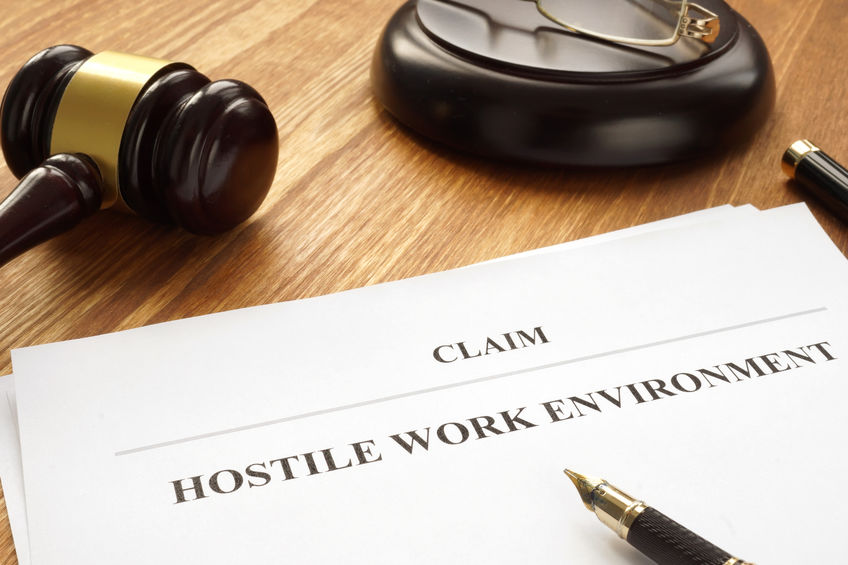A “hostile work environment” is a legal term. For a workplace to be hostile, certain legal criteria must be met. The US Equal Employment Opportunity Commission (EEOC) says that harassment is what creates a hostile work environment. The EEOC defines harassment as “unwelcome conduct that is based on race, color, religion, sex (including pregnancy), national origin, age (40 or older), disability or genetic information.” In other words, the behavior, actions, or communication must be discriminatory in nature.
Simple teasing or isolated incidents, unless extremely serious, are not considered harassment. Such acts would create a toxic work environment, not a hostile one. Although toxic workplaces are not ideal, they are not actionable. The conduct becomes harassment if you are being targeted for your protected class under the law. Harassment targeting things such as weight or appearance don’t belong to any of the protected classes but may still fall under one of the EEOC definitions in certain cases.
Conduct that represents harassment:
- Consistently disciplining an employee more harshly than other employees on account of race, color, religion, sex, national origin, or age;
- Discussing sex acts or using sexually suggestive language
- Inappropriate sexual touching;
- Racist or otherwise offensive jokes;
- A boss taunting an employee for their religious beliefs
- Consistently using highly insensitive language;
- Making unwanted comments about someone’s appearance;
- And more.
Conduct that does not represent harassment:
- A coworker who is rude or passive aggressive
- A supervisor who doesn’t take your ideas seriously.
- A manager who yells constantly and sets unattainable goals or deadlines (with no underlying discrimination)
Is a Hostile Work Environment Illegal?
Harassment in the workplace becomes illegal if the person bringing the claim (1) reasonably believes that enduring the offensive conduct is a condition of continued employment or (2) if the conduct is severe or pervasive enough to create an intimidating, hostile, or abusive work environment to the reasonable person. It is important to note that if an employee suffering from the offensive conduct knows that a report to human resources or other similar anti-harassment reporting office would put an end to the harassment, they will be less likely to maintain the claim.
There is no such thing as a federal “hostile work environment” law. Rather, harassment is a form of employment discrimination that violates Title VII of the Civil Rights Act of 1964. Only protected classes can file a charge of discrimination under Title VII. Things such as weight or appearance don’t belong to any of the protected classes but may fall under one of the EEOC definitions in certain cases. Employees looking to file Title VII charges must do so with the EEOC first before going to court. If the EEOC investigates and decides not to pursue the case any further, the EEOC can issue a “right to sue” letter to the employee that they can use to file a case in federal court within 90 days of the date of the letter.
It is important to note that there is a statute of limitations on these types of incidents. Most EEOC complaints must be filed within 180 days of the alleged discriminatory act taking place. In certain circumstances this deadline is generally extended to 300 days. If employees wait beyond 180 or 300 days, their claims will be dismissed. As long as one act contributing to the claim occurs within the filing period, the entire time period of the hostile environment may be considered by a court for the purposes of determining liability. It does not matter that some of the acts that factor into the claim of a hostile work environment fall outside the statutory time period.
The EEOC also makes it illegal for a reported employer to retaliate against an individual as payback for their reporting of the employer’s improper behavior. This could be by firing, demoting, harassing, or other forms of retaliation.
Does Having a Very Mean Boss Rise to the Level of Having a Cause of Action?
Lets take, for example, a boss who frequently yells or curses at their employees for making mistakes in their work or taking breaks. Can the employees sue the company and/or the boss for hostile work environment?
For someone to have a cause of action against a really mean boss, there needs to be some sort of workplace discrimination or “harassment.” In other words, to be able to sue your boss, you must be able to show that you were subjected to offensive, unwelcome conduct that was severe or pervasive enough to create an intimidating, hostile, or abusive work environment to the reasonable person. Further, you also have to prove that the harassment was based one of the protected characteristics recognized by the EEOC.
If your boss was singling out gay or Latino employees, for example, and directing his unwanted behavior towards them, that might constitute harassment. However, a very mean boss who generally yells at everyone with no underlying discrimination is not harassment for legal purposes and therefore does not constitute a hostile work environment. Being very mean is not against the law.
The fact that your boss’s behavior might be legal doesn’t mean it’s right. You might not have a cause of action legally speaking, but you still might want to consider reporting your boss’ conduct to your HR representative. Even better if there are coworkers that are willing to join you. HR may be willing to step in and take action to squash that type of behavior.
Employer’s Defense to Hostile Work Environment
One of an employer’s strongest defenses in a hostile work environment claim is the Faragher-Ellerth defense. This defense requires the employer to prove that (1) they reasonably took all preventative and corrective measures to remedy the harassment; and (2) the plaintiff unreasonably failed to take advantage of the employer’s harassment complaint reporting procedure set out in the employer’s anti-harassment policies.
The employer must have an established effective anti-harassment policy and complaint reporting procedure in place to be reasonably preventative. An example of an employer taking reasonable corrective action is by conducting a prompt investigation into the matter. If the employer has otherwise taken steps to correct the matter, but its management ignored previous complaints of harassment by other employees against the same harasser, then the employer has not exercised reasonable care in preventing harassment.








